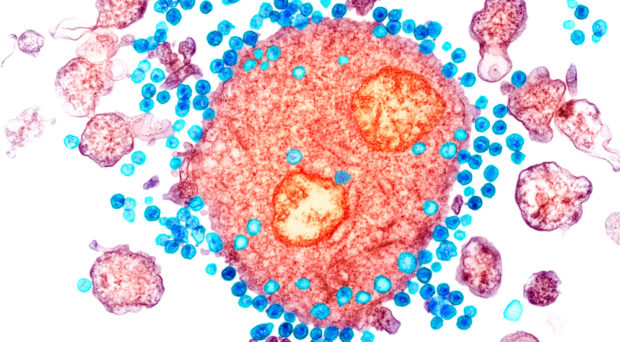
Human immunodeficiency virus type 1 (HIV-1) establishes a persistent infection, resulting in acquired immunodeficiency syndrome (AIDS) if left untreated. Around 37 million people in the world live with HIV with a global HIV prevalence of 0.8% among adults. Combination antiretroviral therapy (ART), introduced in 1997, has saved millions of lives, as it suppresses HIV-1 replication and improves immune responses, preventing the development of AIDS.
However, ART has to be taken lifelong, is prone to side-effects, and is unable to eradicate the virus. On top of that, 40% of HIV-infected people in the world still do not have access to ART. Therefore, HIV-1 cure research has flourished in recent years, inspired by an apparent cure in a single individual (“The Berlin Patient”).
By establishing latent infection, HIV-1 forms a long-lived reservoir in infected individuals, which persists despite decades of suppressive ART and is considered the main obstacle to an HIV-1 cure. Studies of the viral reservoir are thus central to HIV-1 cure research. The viral reservoir in an infected individual is defined as the number of cells carrying replication-competent proviruses (viral genomes that are integrated into host chromosomes and capable of reigniting viral spread when ART is stopped).
The frequency of HIV-1 reservoir cells in long-term ART-treated individuals is estimated as 1/100.000 – 1/1.000.000 of peripheral blood CD4+ lymphocytes, although it might be somewhat higher in tissues and varies significantly between individuals. However, stopping ART almost inevitably leads to fast viral rebound, indicating that eradicating or at least significantly depleting the reservoir will be necessary to achieve an HIV-1 cure or long-term ART-free remission.
Measuring the HIV-1 reservoir
Despite the challenges presented by the extreme paucity of the reservoir cells, accurate measurement of the viral reservoir is necessary for monitoring the effectiveness of interventions aimed at HIV-1 remission or cure. Unfortunately, while significant progress has been made in our understanding of HIV-1 biology and pathogenesis, the composition and dynamics of the viral reservoir and the mechanism(s) of HIV persistence remain largely ill-defined. In particular, it has been challenging to precisely measure the size of the HIV-1 reservoir.
Quantitative PCR-based methods to measure the HIV-1 DNA provirus numbers are highly sensitive, but grossly overestimate the size of the reservoir, because most proviruses in ART-treated individuals are defective for production of correct viral proteins and infectious particles. On the other end of the spectrum, the viral outgrowth assay (VOA) has an advantage of measuring only replication-competent proviruses, but is labor and time intensive, and underestimates the reservoir size.
Between these extremes, assays that measure expression of different cell-associated HIV RNA species or viral proteins provide a better estimation of the reservoir size, but still somewhat overestimate the reservoir. Therefore, despite decades of hard work in the HIV-1 research field, the size and biological properties of the HIV reservoir still remain elusive.
The Retrovirology collection
The review collection “Measuring HIV-1 persistence in vivo”, published in Retrovirology in 2017-2018 and edited by Dr. Alexander Pasternak and Prof. Ben Berkhout (University of Amsterdam), presents the state-of-the-art methods of HIV-1 reservoir measurement. Fourteen review articles included in this collection, written by leading scientists in the HIV-1 field, summarize the current knowledge on the utility of different HIV-1 molecular forms for use as biomarkers of viral persistence in infected individuals. They also describe methods to quantify these markers, which range from simple PCR assays for HIV-1 DNA to more innovative approaches, such as mouse viral outgrowth assays, single-cell techniques, digital PCR, and next-generation in situ hybridization methods.
This collection will not only serve as a reference for HIV-1 scientists, but will also educate non-HIV researchers interested in the possible application of the described methods to the measurement of other pathogens.
Sun Tsu, the ancient Chinese military strategist and writer, has famously said “know your enemy before you go to war”. As any form of HIV cure will not be possible without defeating the viral reservoir, we need to accumulate much more knowledge about the reservoir before we can design a meaningful therapeutic intervention. The Retrovirology collection provides a valuable inventory of the dissection tools we currently possess, as well as guidance on their optimal use.
Comments